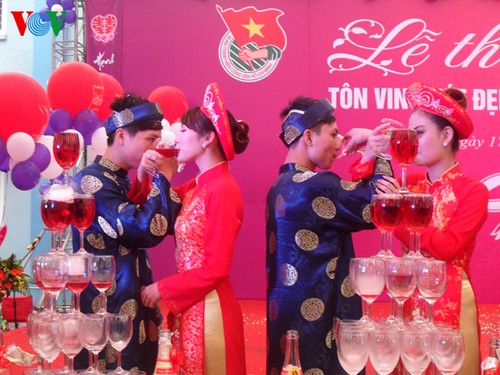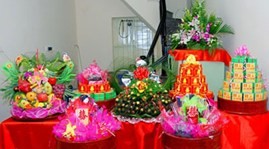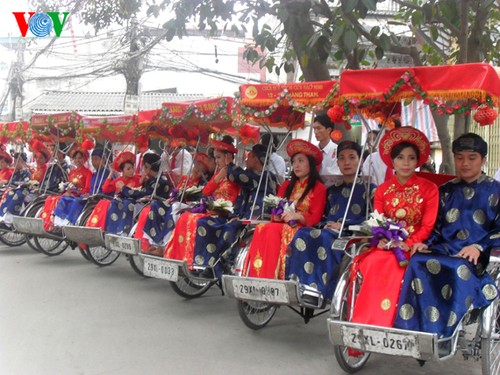(VOVworld) – The Viet people consider marriage a central event in their life. Wedding rituals differ by regions but are among the most typical features of the nation. Despite social development, traditional rites still play a significant role in Viet weddings.
 |
For the Viet people, marriage is one of the three major events of one’s lifetime, along with buying a buffalo and building a house. According to an old tradition, the wedding date is chosen based on the bride’s age. If her age ends with 1, 3, 6, 8, the wedding shouldn’t be held in that year. Formerly, a wedding involved 6 main steps, but now the figure is reduced to 3: Dạm ngõ (marriage proposal), Ăn hỏi (betrothal ceremony) and Lễ cưới (wedding). In the ceremony to offer marriage, the groom’s family comes to the bride’s house to officially seal the commitment to marriage. Vu Thi Thanh Tam, a culture expert with the Vietnam Museum of Ethnology, says: “Through this ceremony, the two families learn about each other’s backgrounds, leading to the decision to hold a wedding for the couple. The offerings used to be simple: only betel and areca. But today, there may be some fruits, wine, tea, and confectionery. From the marriage proposal to betrothal ceremony, there is no definite period. It can be 3 months or a year”.
 |
Offerings for the betrothal ceremony are prepared as requested by the bride’s family, including betel, areca, tea, sugar-coated lotus seeds, and cakes. The groom’s family - his parents and close relatives - bring these betrothal gifts to the bride’s family. The gifts are carried by unmarried boys and received by unmarried girls. In this ceremony, the two families set the date and agree on the formalities of the wedding. Tam says: “The gifts are placed on the altar of the bride as offerings to the ancestors. Then part of them are returned to the groom and the rest are divided into small portions with each including a betel leaf, an areca, a small package of tea, some sugar-coated lotus seeds, and cakes. These portions and wedding invitations are delivered to the bride’s relatives and friends. Only invitations are given to the groom’s family and friends”.
 |
The wedding ceremony consists of xin dâu (asking the bride to move to her husband’s house) and rước dâu (meeting the bride and bringing her home). An elder and high-status person, representing the groom’s family, leads the xin dâu ceremony. At the bride’s house, the couple burn incense to pay tribute to the ancestors and then offer the participating relatives some betel and areca.
Arriving at the groom’s house, the couple again burn incense at the altar of the ancestors. One important rite is to stretch out mats. According to Tam, “Mats are spread out in the couple’s room to wish them happiness, longevity and abundant offspring. The person who performs this work is a matchmaker, the groom’s mother or an elderly person who has many children and grandchildren and is kind-hearted and indulgent. This rite is still important today, particularly in rural areas”.
A wedding in the Mekong river delta is more complicated and time-consuming. The delegation that visits the bride’s house must include the clan chief and a matchmaker. The number of participants should always be even because even numbers represent couples or pairs. Vo Mai Phuong, an expert with the Vietnam Museum of Ethnology, says: “The ceremony of meeting the bride and bringing her to the groom’s house in the Mekong delta is similar to that in the northern delta. The couple has to burn incense to the ancestors. But in the Mekong delta, the groom must hold the bride’s hand all the way home, symbolizing that the couple will stay together despite any obstacle to split them”.
The couple’s first visit to the bride's family takes place 3 days after their wedding. The gifts they bring with them are chickens in the north and ducks in south. “In the north, betel and areca are very important, which is different from the south. In the Mekong delta, the compulsory gifts are a pair candles, in addition to regular items such as wine, tea, and cigarettes”, said Phuong.
Viet weddings have been simplified, but retain their traditional features, celebrating the most important event of a person’s life.